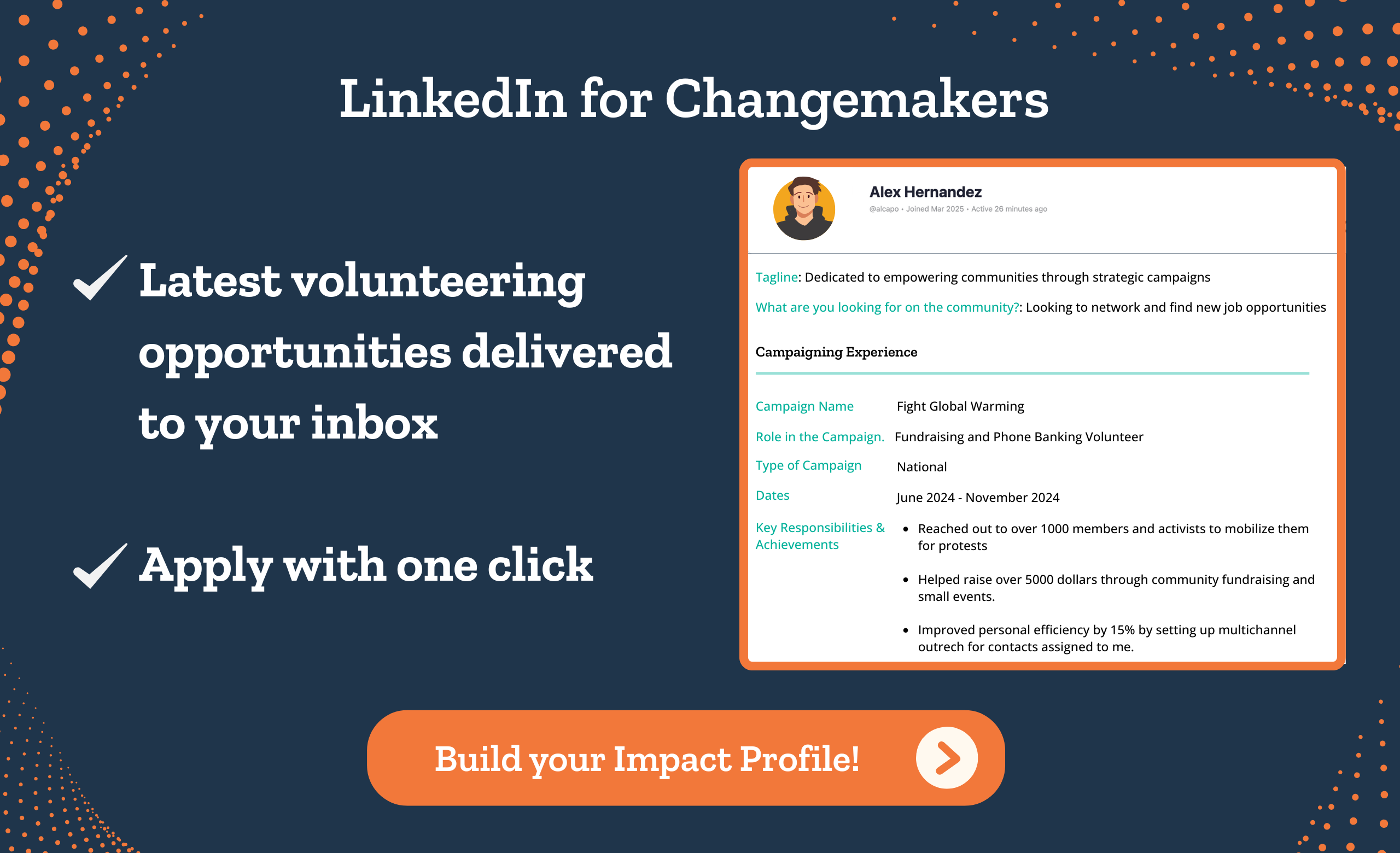Table of Contents
Year after year, colleges and universities are up for tough competition to meet their admission targets. It has become necessary to employ effective student recruitment strategies that attract prospects to your college and compel them to secure admission.
Let’s look at various student recruitment strategies that can:
- Attract interested students to the top of your prospect funnel,
- Guide them to the middle and,
- Compel them to move on to the bottom and enroll.
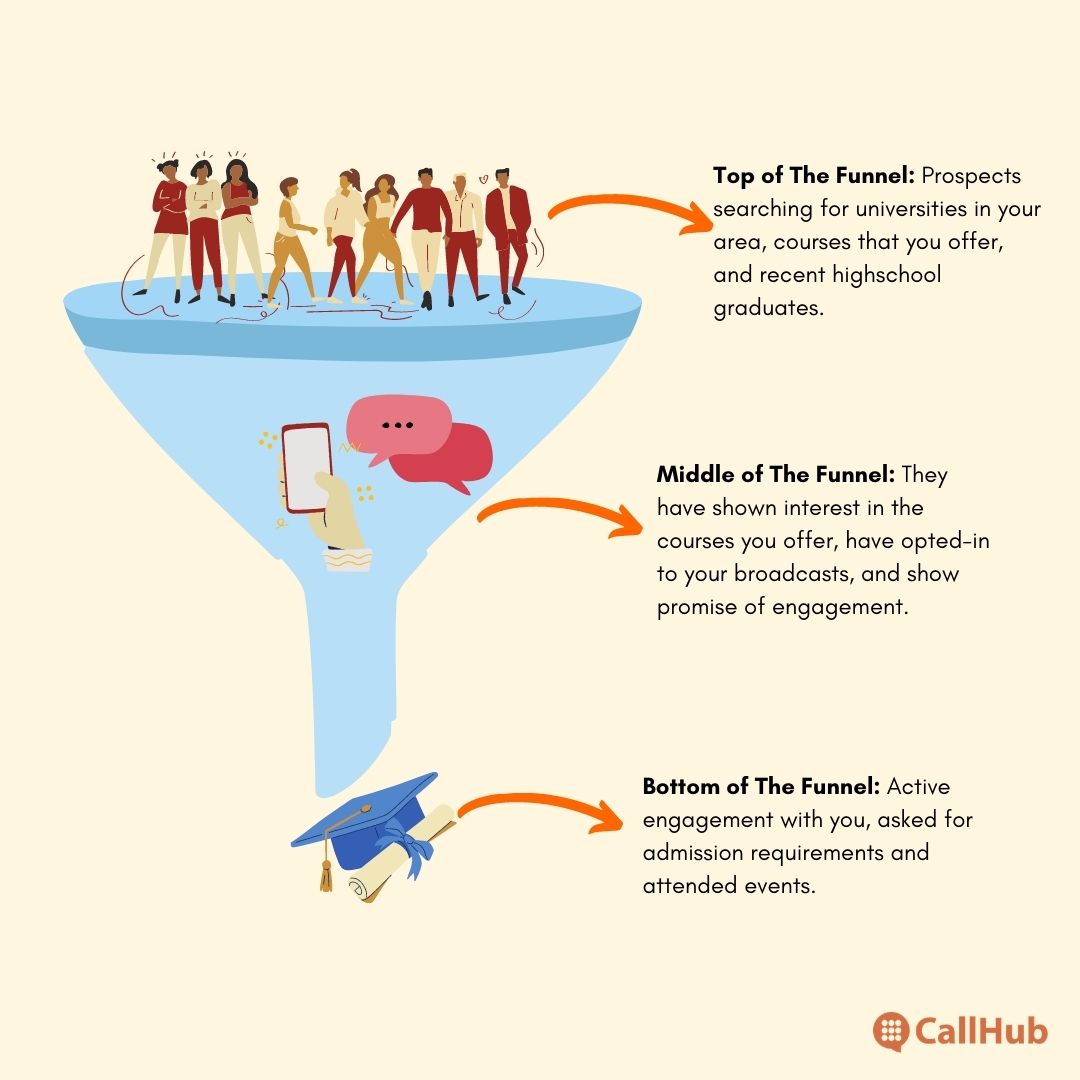
Top of the Funnel student recruitment strategies: How do I attract students to my college?
The Top of The Funnel (TOFU) is the stage where you market your university and get the attention of as many real prospects as possible. Your prospects are recent graduates, individuals looking for courses in your area, and those looking to enroll in your type of institution (private college/public university, community college, etc.)

1. Optimize content for online attention
It’s a no-brainer that Gen Z is hooked to the net and conducts most of its business online. Researching colleges and universities that best match their expectations is no different.
This is why your student recruitment strategies must focus on optimizing online content to ensure you appear on their search results and compel them to open your pages.
Remember that every university and college fights for their attention (the average attention span is just 8 seconds!).
Here’s how you stand first in line to earn their attention.
Best practices to optimize online content:
- Optimize SEO: They say the best place to hide a dead body is on the second page of Google. And why not? 95% of all search traffic never goes beyond page 1 of Google. The first ten queries get 208% CTR. These two statistics show how important it is to appear on the first page and compete for the top 10.
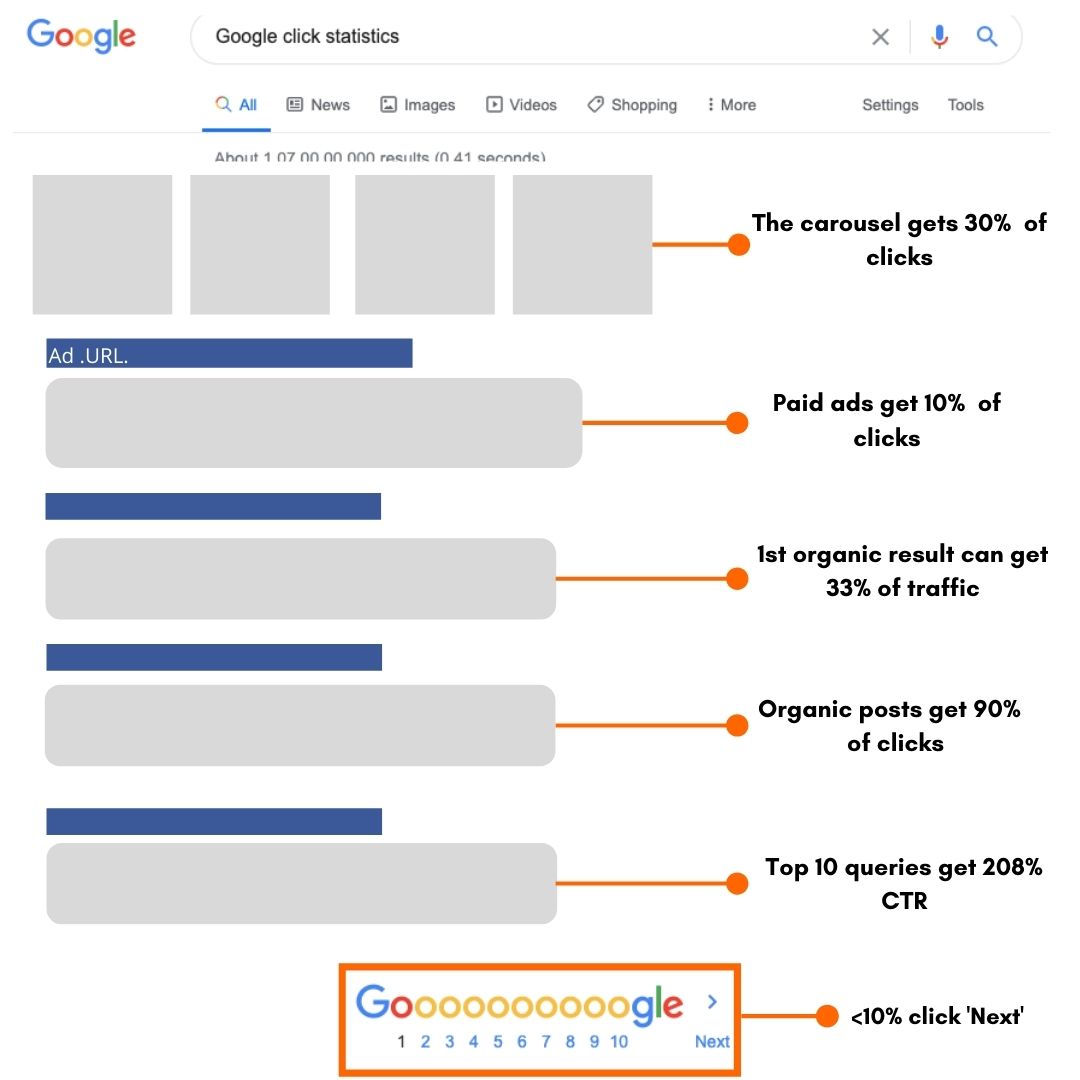
- Mobile-optimized website and landing pages: According to a 2019 study by eMarketer, teens (aged 13-17) spend 62% of their screen time on phones. So, if your website doesn’t fit well on their small screens or isn’t otherwise mobile optimized, you lose the young prospects’ attention.
- Use accurate targeting for the audience: Facebook, Instagram, and Twitter ads should appear on feeds of people looking for courses in your country and in locations that are allowed to travel in your country (due to COVID-19 restrictions).
- Videos are no longer an option: Gen-Z watches 2-4 hours of YouTube videos daily. Since videos are aesthetic, concise in providing information, and can maintain attention, they are critical for your student recruitment strategies.
Read More: Mobile Marketing Strategies and Tips
2. Use creative online marketing strategies
As per Hanover Research, many universities have hired corporate marketers, including CMOs, and invested considerable time and money building strong institutional brands.
Here is what one such university did:
The University of Salford made finding a college course fun, exciting, and as personalized as finding a date online. In 2016, they ran a campaign in partnership with Tinder called ‘Match Made in Salford’. The campaign made it possible for students to find last-minute courses with their app. Like the dating app, this initiative used personal details, albeit suited for educational institutions, such as students’ grades, course choices, career options, and more, to find the perfect course for them.
Given how popular dating apps and personalized content are for the young generations, this campaign was a huge success, and Salford’s marketing director said they helped 10,000 candidates find a match.

This is a classic example of getting a large number of prospects onto the TOFU list. Similarly, an innovative marketing strategy can be a valuable addition to your student recruitment strategies.
Best practices for student recruitment strategies through online marketing:
- Use a unique, memorable hashtag, so your campaign is easily searchable. Add relevant trending/popular hashtags so those unaware may also get your campaign in their results.
- Always include a link to your website or landing page in your posts. This helps you direct prospects to the desired page directly and makes it convenient for them as well.
- Make your campaign fun and attractive – because what campaign goes viral if you can’t find joy or meaning?
- Put up banner ads on relevant pages (e.g., educational blogs.)
- Create different content for different social media sites: Facebook, Instagram, and Twitter work on different algorithms and, hence, push engagement on various content forms. Study the latest trends on each social media platform you use and tailor content accordingly.
Read Next: What Is Recruitment Marketing And How Can You Use It To Hire The Right Candidates
3. Lead with usability, simplicity, and transparency
Marketing your college or university is not just about grabbing eyeballs but also showing why their attention is worthwhile right where prospects find you. To do this, you must address three questions in the marketing phase of your student recruitment strategies:
- Why should one choose your university? (Usability)
- How do you convey this to TOFU prospects? (Simplicity)
- What are the realistic prospects for a student before and after graduation? (Transparency)
Best practices:
- Get alumni and faculty to talk about your university.
- Cut through the chaos by using minimalistic designs (for your images, logos, and messaging)
- Offer online tours and seminars for students who can’t travel to the campus.
- Use your social media posts, emails, and SMS broadcasts to inform them about what to expect from your institution, what challenges they may face, and to resolve doubts.
- To show transparency, you could maintain blogs about overcoming challenges (financial, emotional, academic, etc.). Similarly, you could advertise your career guidance departments and (if relevant), campus placement opportunities as part of your marketing plan.
You May Also Like: Contacting Alumni Email Sample and Tips To Enhance Your Interactions
4. Partner with highschools and communities where you’ll meet prospects
While online communities and social media campaigns are a great way to connect with people across geographies, you need a more local connection to populate your TOFU list.
College and university student recruitment strategies must focus on partnering with schools, churches, local businesses, and other communities to form bonds with prospective students.
Best practices to partner with local communities:
- Hold school events and encourage students to opt-in to your broadcasts via SMS and email so you acquire their contact details for future communication.
- Be constantly in touch with principals, churches, HRs, and other people in authority positions and ask them if anyone has shown interest in higher education. Request the contact details of interested individuals.
- Nurture your alumni network so that they help you get prospect leads and refer you to interested friends and family. They can act as student advocates for your university by sharing their experiences with prospective students and guiding them ahead.
- Put up posters and banners in your city introducing your university, broadcasting updates, and inviting students to opt-in to your messaging lists.
- Hold job fairs and virtual campus tours. Collect the participants’ contact details and follow up with those who show interest.
5. Set strategies to target and recruit minority students
According to the 2018 US census reports, the diversity of graduate students stands at these numbers:
- 61.2% are white non-Hispanic students
- 13.6% are Hispanic
- 12.3% of graduate students are Black
- 11.2% of the students are Asian.
While the numbers show that most graduate students are typically white, millennials value equal opportunities to diverse groups as a matter of principle. All qualified students, irrespective of their ethnic, sexual, or cultural orientations, income levels, disabilities, etc., deserve equal opportunities to study in esteemed colleges.
This is why you need concrete strategies to enroll minority students and ensure equal opportunities.
Best practices to recruit minority students:
- Tap the ‘unmatched’ market of low-income students: Students with qualifying grades and test scores but low family income tend to opt for less selective colleges. Students from the lowest income quartile make up only 4% of admissions to selective colleges. Approach promising students (irrespective of race and ethnicity) with low incomes and share your scholarship opportunities and financial aid prospects with them.
- Take affirmative action to encourage students from racial or ethnic minorities to secure admission with you. (However, check the constitutionality of your initiative beforehand).
- Provide special financial assistance to minority students from low-income groups (since statistically, income levels are lower with racial and ethnic minorities).
- Make necessary changes in administration, student recruitment policies, and mentoring programs to encourage admissions for minority students. For example, you could actively reach out to minority schools and communities to recruit students to your college.
6. Tell your campus story
Show your prospective students the benefits and value they get out of joining your institution versus any of your competitors’ (without directly mentioning your competitor institutions, of course).
Universities consider the campus story to be one of the most important student recruitment strategies.
For instance, Stanford University shows what it’s like to be at Stanford using a walk-through video while interviewing students. The video takes you on a virtual tour of the campus from different angles, including aerial views, and focuses on all the state-of-the-art facilities.
The video has got 564,935 views and over 16,000 likes.
Life inside the campus is one of the most intriguing factors for students before considering joining the university. Make sure you highlight the most appealing features to capture their intrigue.
Best practices:
- Talk to board members, the principal, and professors to get their insights into your story. Since everybody plays a different role, you may get different angles from them all.
- Consider the ‘Why’. Think about the purpose of your story. Do your prospective students want to know this? What do you want them to feel? Ask yourself questions like these before you finalize your story.
- Introduce characters. People are most likely to relate to a story involving relatable characters. Have different persons with characteristics or stories that appeal to a large portion of your target audience.
- Show your students’ journeys. Highlight the conflicts and then the resolutions. Help your prospective students feel like they belong with you.
- Make sure your story reaches a broad audience. Since the intention here is to get high visibility, share your story on all your marketing channels. Request the people in your story to share it on their social media handles.
- Repurpose the story into a blog, an interview document, a podcast, social media posts, and more.
7. Publish student-generated content
Content generated from your students or alumni can favorably impact your prospective students’ decision-making process. Student-generated content is authentic, one of the best forms of content to attract your prospects.
Harvard uses this form of student recruitment strategy to attract students. Here’s an example.
Best practices:
- Figure out the type of content you’ll publish and the platform you’ll publish it on. For instance, short walkthrough videos on Instagram may have worked well for your competitors. This is a sign that it’s time you give it a try.
- Provide specific instructions on how students can associate your institution with their content. Do they need to use a hashtag? Do they tag you? Specify.
Middle of the funnel: How do I engage with promising prospects?
This is where many contacts from your TOFU list will drop off. Don’t worry–the aim isn’t to lead all of the prospects to the bottom of the funnel but only those who are truly engaged and show promise.
Prospects in the Middle of the Funnel (MOFU) are not just interested in taking admission to a college but:
- Are keen on pursuing courses that you offer,
- Have shown interest in your college and
- Have maintained some connections (following on social media, opting in to your SMS/email list, etc.).
Let’s look at ways to nurture this interest and lead the TOFU prospects to MOFU with effective student recruitment strategies.

1. Set up communication channels that the students are most comfortable with
According to a 2016 study conducted by Ruffalo Noel Levitz, here’s how students prefer the first contact with colleges:
| Method of Communication | Four-year private institutions | Four-year public institutions |
| Email (with personalized/branded link) | 37% | 33% |
| Self mailer brochure/postcard | 30% | 37% |
| Phone call | 20% | 22% |
| Letter | 19% | 16% |
However, these numbers are mere guidelines for what students may prefer. Your prospects may or may not have the same preferences. To ensure convenient communication with them,
- Provide them with communication options when signing up.
- Or conduct an email or text survey to ask their preferred mode of communication.
To know more about building a marketing list (for SMS), read this post.
Best Practices:
- Segment lists according to preferred modes of communication and send them broadcasts (or call them) to confirm their opt-in on the respective channels.
- Notify them of how many messages to expect in a week or month.
- For messaging, discuss life at the university or your city with prospective students. Address any issues they have with in-depth conversations (rather than close-ended questions and scripts).
- Use broadcasts to send messages like faculty qualifications or alumni achievements. Use peer-to-peer texting, phone calls, conversational emails, or chatbots to discuss their desired course in more detail (than what’s on your website).
- Assign specific student success agents to the prospects so they always have one point of contact, and you can build a relationship with them.
See how you can improve your student recruitment strategies and engage students with CallHub’s texting and calling tools.
2. Personalize data to show them you care
Earlier, we saw how the University of Salford used personalization to match 10,000 students with courses that suit their choices and career interests. This worked phenomenally because the young generation is used to personalized communication– they almost take it for granted.
Gen Z has grown up in the era of social media, curated online shopping options, personalized search results, etc. So, if a university takes a one-size-fits-all approach, it wouldn’t work with the prospects.
Best practices for personalization in student recruitment strategies:
- At this stage, you cannot just target prospects with ads about your university. It would be best to target prospects in the MOFU stage with ads about specific courses, extra-curricular activities, scholarships, and events.
- Use calling software, like CallHub, that integrates with your CRM and enables you to import and update contact data.
- Your email and recruitment text marketing software must sync with your CRM to personalize broadcasts and update information based on your 1-on-1 conversations.
- Coordinate data between different communication channels to give prospects a comfortable, intelligent experience (e.g., If a prospect has answered an email survey and a new agent sends the same survey over text, it could result in inconvenience or minor disappointment. However, if your data is synced, an agent can see a prospect’s responses to the email survey and take the nurturing forward.)
3. Set priorities– and more importantly, “Posteriorities”
When you are at the MOFU stage and proceeding to the Bottom of the Funnel (BOFU), it’s crucial to note the prospects most promising. Based on this, you can decide which of them need nurturing and which of them can be filtered out– The former are your priorities and the latter, ‘posteriorities.’
Peter F. Drucker, the “Father of Modern Management Studies,” defines ‘posteriorities’ as “deciding what tasks not to tackle and…sticking to the decision.”
The decision is difficult, no doubt. However, it will save you time and resources by enabling you to focus only on those individuals who are likely to stay connected with you.
Take this situation for example:
| Prospects | Prospect A | Prospect B |
| Pros | ✓ Belongs to an area that has traditionally brought you many admissions ✓ Interests match a course you offer ✓ Finances are in place. | ✓ Opted-in to your SMS list ✓ Replied to your emails ✓ Has lengthy phone conversations with your agents. |
| Cons | ╳ Hasn’t actively interacted with you | ╳ Belongs to an area that hasn’t traditionally seen much traffic in your college. |
Although a tough decision to make, you must categorize A as posterior while prioritizing communication with B. Nurturing with B needs to take precedence over follow-ups with A.
Best practices to set priorities and posteriorities:
- Set definite guidelines to categorize students as priorities and posteriorities– What aspects do you value most (when calculating the chance of confirmation)? How risky would it be to reduce conversations with posteriorities?
- Dedicate communication, financial, and human resources proportionately to each category. More resources go to the priority and most minor to the last posteriority.
- Craft a plan that can scoop up folks from ‘posteriority’ top priority if something crucial changes (e.g., they suddenly start conversing, or you realize you might not fill seats for a course).
4. Offer valuable resources that help them with the admission process
Applying to the right college can be a bit of a puzzle, especially without proper guidance and resources. This is why students tend to seek out free resources. You can help them out and guide them down the right path.
Most student recruitment strategies consider free resources as one of the ways to attract prospective students.
Here are some examples of resources that prove to be valuable for your prospective students:
- Advice on college admissions
- Materials to help with entrance test preparations
- Finding sponsorship for admission
- Documents that act as the local guides.
Best practices:
- Manage all resources in a single repository so students can pick from what is most helpful.
- Update your resources occasionally and keep up with the trends and developments.
- Consider offering the resources in exchange for your prospective students’ contact information and get them started on the nurturing journey.
Bottom of the funnel: Student recruitment strategies to inspire prospects to secure admission
Individuals in the BOFU are your most engaged prospects— they have shortlisted your university, and now is the time to make the last efforts to show you are the perfect match. These prospects have actively engaged in conversations, requested admission requirements, and attended an event(s).
Once both you and them are sure that you could be a good fit for each other, you start the final stage of nurturing, where you guide them from the ‘most promising’ stage to ‘confirmed admission.’

1. Discuss finances
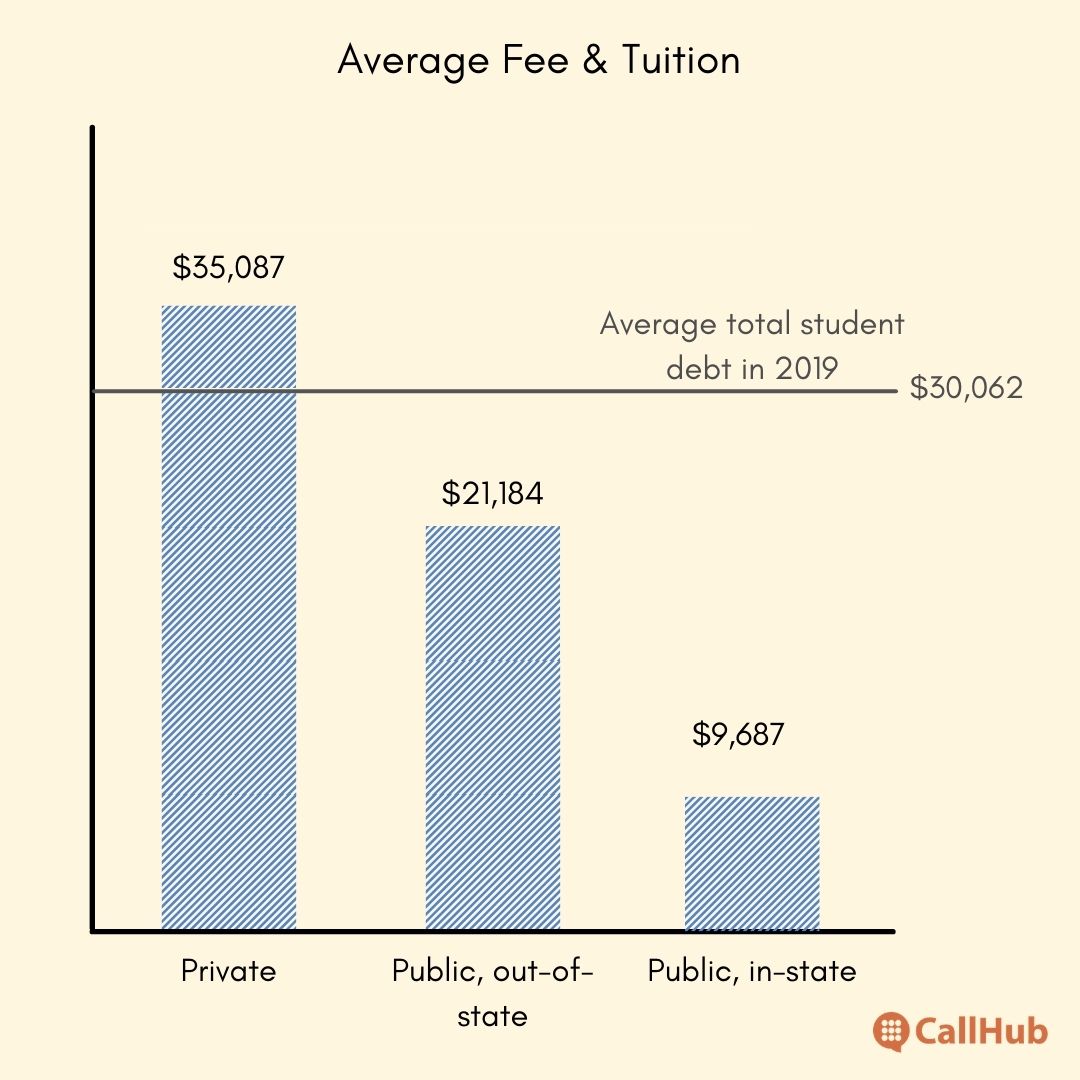
Higher education is perhaps the first significant financial investment a person makes. Thus, it is essential to be transparent about finances here.
At this stage, when students are probably counting the pros and cons of the shortlisted universities, you need to ensure you don’t enter the field of ‘too expensive’. Here’s how you can simplify
Best practices to discuss finances:
- Give a breakdown of expenses– including fees and tuition, accommodation, cost of living, and miscellaneous expenses. The whole looks greater than the sum of its parts.
- Discuss scholarships, financial aid prospects, and eligibility.
- Conduct seminars about money management that current or old students have found helpful.
2. Leverage your alumni network and faculty to help prospects where they need it: student recruitment strategies
Your student recruitment strategies must also include learning lessons and getting help from the past—in this case, from your alumni.
Engaging alumni while recruiting students helps in the following ways:
- Allows peer-to-peer sharing of information– Alumni can discuss what’s in the brochure, what’s not, and how to tackle the latter.
- Adds authenticity to the student recruitment process.
- Establishes trust.
Best Practices for leveraging alumni as a student recruitment strategy:
- Leverage star alumni with exceptional careers to give motivational talks/discuss career prospects.
- Form alumni-student buddy programs to prepare candidates in the final stages of nurturing.
- Get faculty and alumni from particular departments to conduct online introductory sessions.
3. Retouch base with prospects who have trickled out: student recruitment strategies
Follow-ups are one of the most important student recruitment strategies universities deploy. Retouching base with prospective students who have dropped out can help your recruitment numbers and percentage. Here, it would be best to consider both MOFU and TOFU prospects, while prioritizing the former.
Why MOFU prospects: They may have dropped off due to a lack of connection with you. Starting from the marketing stage for fresh candidates will require more resources. If your target numbers don’t match, chat with MOFU contacts first.
Why TOFU prospects: Students may not have gotten admission in the college of their choice, New restrictions may have held them behind, or other issues, such as financial constraints, may have prevented admission to other colleges.
Best practices for these student recruitment strategies:
- Call students whose reason for dropping off is apparent– Segment them into lists (e.g., financial constraints/unmatched opportunities/visa issues) and contact them with relevant information. Since calls are extremely personal, connecting with dropped students this way will show you value them.
In California, a film school contacted 223 prospects with a message concerning their financial aid status using CallHub. They had previously sent an email but couldn’t get the desired attention, hence the phone call. After the calling campaign, they got 15 transfers! Here’s the script they used:
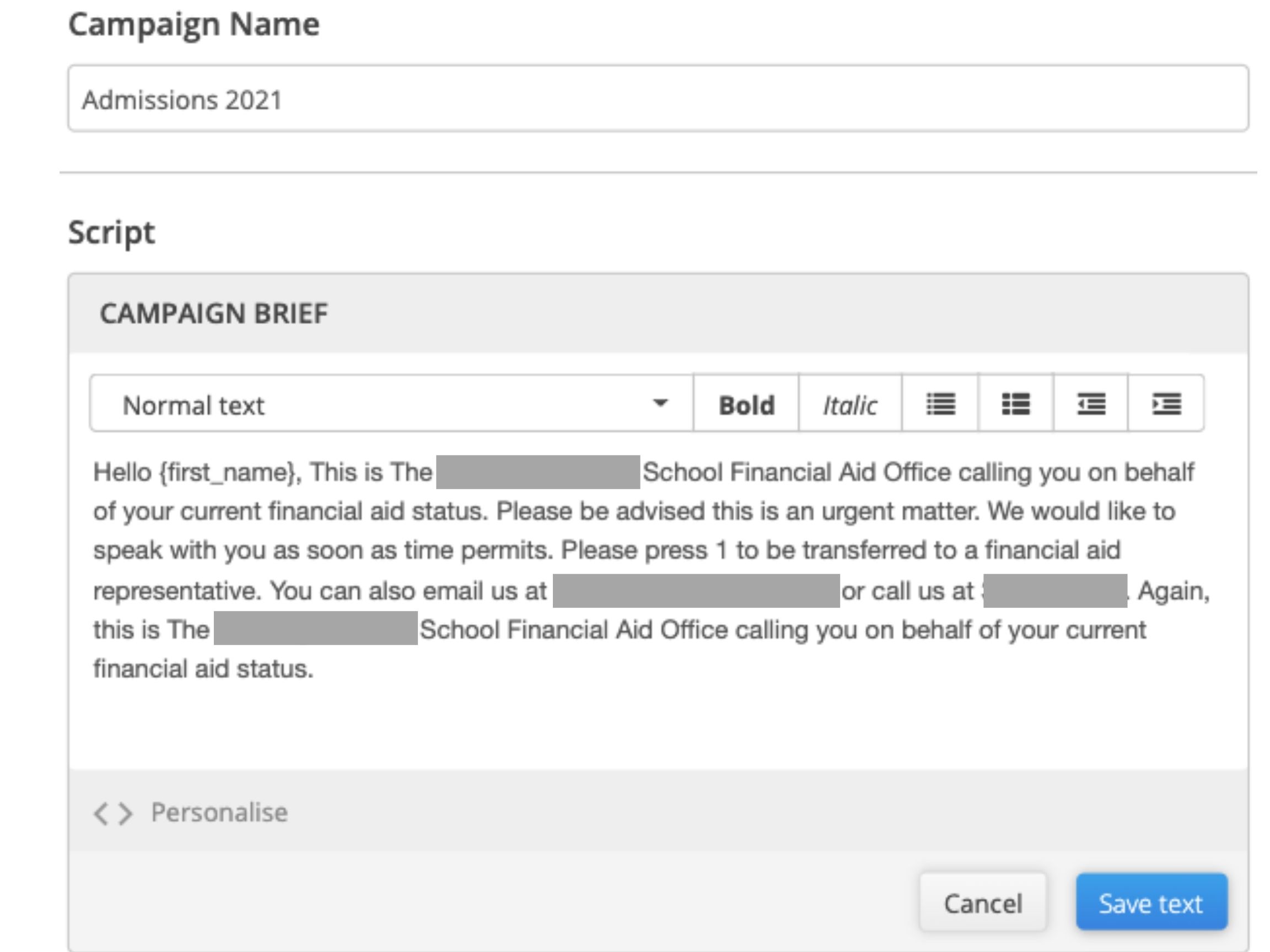
- Send texts and emails with surveys if you’re not sure why they dropped off.
- Send text or email blasts to bring to their attention the opportunities they may have missed or developments that may get them interested in you again.
- Nurture them using the same recruitment strategies you used for other successful prospects in the TOFU and MOFU lists.
Retaining current students is just as important for colleges and universities as securing new admissions. Low graduation rates show that many students drop out of higher education midway. Studies show that:
- For private colleges, the four-year graduation rate is 52.8%, and the six-year graduation rate is 65.4%.
- For public universities, the rate is 33.3% and 57.6%, respectively.
While some of these numbers reflect academic failures, they also indicate dropout rates. In addition to effective student recruitment strategies, ensure that students in your institution leave with a completed degree. Read: Student Retention Strategies: How To Decrease Dropout Rates.
4. Set up effective and approachable communication mediums for student recruitment strategies
Communication is the backbone of a recruitment strategy. The right message at the right time to the right target greatly impacts your results. A sophisticated communication strategy always accommodates (or prioritizes) channels that work well with and are preferred by the target audience.
In your case, the largest audience is Gen-Z individuals—the texters who always have their phones handy. This makes text marketing an important weapon in your armour. You can further empower texting with automation software.
An SMS marketing software such as CallHub can:
- Send a text message to all your prospective students simultaneously.
- Allow them to respond with queries.
- Create a nurturing flow that defines actions depending on the responses.
Now, why is CallHub’s texting tool an ideal choice here?
- The list segmentation ability on our platform prevents sending a generic text to all contacts.
- Allows at-scale personal communication in a short time.
- Text messages enable two-way conversation.
- They assure better response rates than emails.
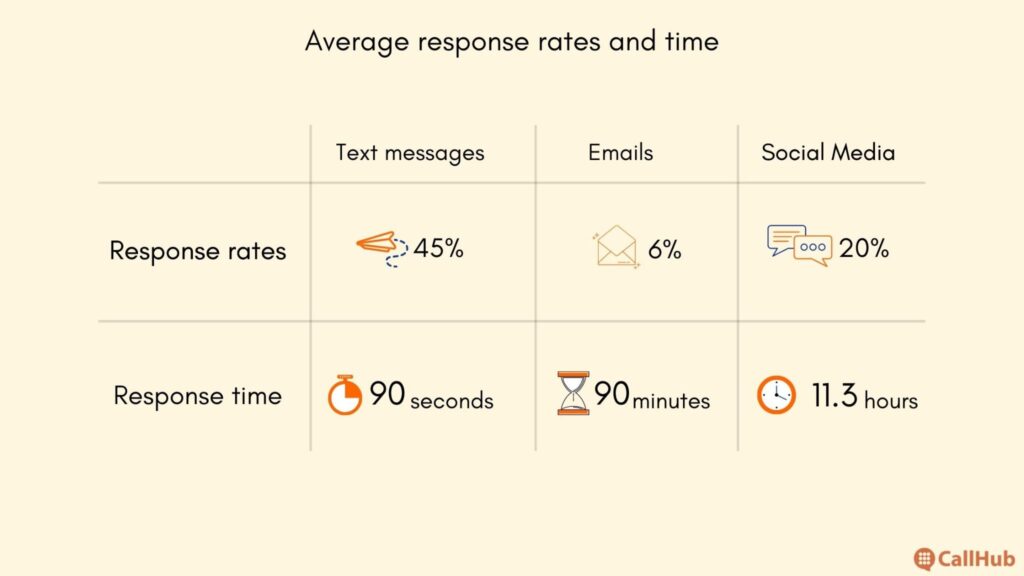
Furthermore, the ability to schedule and automate communications enhances deployment processes. Thus, your staffers can focus purely on engaging and nurturing prospects, leading to increased enrollments.
So, how can you schedule a text update on CallHub?
- Select ‘Text Broadcast’ on the screen.
- Select the contact list and rent a phone number.
- Draft your message, add merge tags for personalization, and set up auto-responses to anticipated replies.
- Add the email address where you want the notifications for the replies sent.
- Schedule your campaign by the deployment date, the days, and the activation time.
Now, let’s see how your prospective students can reach out to you using CallHub’s texting tool:
- Select ‘Peer-to-Peer Texting’ from the screen.
- Add the scripts and the saved replies for your agents to use. You can also add shortened links, which you can track’s performance.
- Choose your contact list and rent a phone number.
- Assign agents for your campaign.
- Schedule your campaign by the deployment date, the days, and the activation time.
Best practices for student recruitment strategies:
- Craft an engaging message and stay authentic and relevant.
- Set the correct timezone based on your contact’s location.
- Let your contacts know that if they aren’t interested in hearing from you, they can opt out and give an easy way to do so. They can do this by replying with trigger keywords, which automatically opt the contact out, such as, STOP, QUIT, CANCEL, UNSUBSCRIBE.
- More importantly, take your contacts’ consent before sending them text updates. Your prospects can express their consent by opting into your updates. Our SMS opt-in tool is the ideal choice here.
The way forward with student recruitment strategies
These student recruitment strategies will help you attract, engage, and get them to enroll. When you use texting and calling to connect with your prospective students, you can personalize your conversations to a great degree. This will make your prospects feel heard and consider you over your competitors.
Feature Image Source: Mikael Kristenson/Unsplash.

